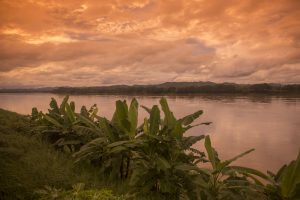Hydropower projects, including a spree of mega-dams in China, have had a significant impact on the midstream reaches of the Mekong River, exacerbating drought conditions and altering the river’s flow in fundamental ways, according to a group of U.S.-based researchers.
The finding was contained in a report assessing the first year of data gathered by the Mekong Dam Monitor (MDM), which is operated by the Washington, D.C.-based Stimson Center and the American research firm Eyes on Earth.
“Data shows that dams have exacerbated wet season droughts and in some places have inexorably altered the natural flow patterns of Southeast Asia’s most productive river,” stated the report, which was based on a composite of MDM observations and data from the Mekong River Commission (MRC).
The MDM, which was officially launched in December 2020 and is partly funded by the U.S. State Department, employs remote sensing and data from cloud-piercing satellites to track water levels along the Mekong River, which stretches for 4,350 kilometers from the icy plateau of Tibet to the South China Sea.
In recent years, the lower half of the Mekong, which runs through Thailand, Cambodia, Laos, and Vietnam, has experienced a number of punishing droughts that have sent water levels to all-time lows. (As the MDM report notes, the year 2020 was the driest on record.) Environmentalists and riverside communities have also observed an increasingly erratic pattern of rises and falls in water levels.
Partial blame has come to rest on the Mekong hydropower projects, particularly the cascade of 11 large dams on the upper reaches of the river in China’s Yunnan province, which have come on line gradually over the past two decades. In April 2020, Eyes on Earth published a study claiming that Chinese dam reservoirs had held back excess monsoon rains across six months in mid-2019, significantly worsening drought conditions downstream.
The MDM’s first year of data seems to confirm that while upstream dams may not be the primary cause of the river’s problems, which also include El Nino weather patterns and the broader impacts of climate change, they have greatly magnified their effects. The report stated that the “severe lack of rainfall” was the core driver of drought and low river flows in the period 2019-2021. But it added that “dam restrictions during this period significantly impacted wet season flow and exacerbated drought conditions throughout the basin,” where some 66 million people rely on the Mekong and its resources.
“At some parts of the Mekong Basin the impoundment of water and unnatural releases from dams have entirely altered the natural flow of the river,” the report stated. It pointed out that even though the amount of water held back by some Chinese dams remained constant, in drought years this made up a larger proportion of the river’s total flow, and hence had an outsized impact.
The impacts were particularly severe in the upstream stretches of the lower Mekong north of Vientiane, the capital of Laos. On this stretch of the river, “ecological processes… and the social practices that rely on these processes, have likely been inexorably altered.” It added that in other parts of the river, “the situation is more complicated.”
Since coming online in late 2020, the MDM has offered valuable insights into how man-made alterations, particularly dams, are impacting age-old ecological patterns on the Mekong River, as well as providing advance warnings to downstream nations about likely changes in the river’s flow. But as the report notes, the Chinese government “has yet to share sufficient data on the operation of its dam cascade.” While Beijing has pledged to notify downstream nations of dam reservoir releases and other disruptive events, these have generally come too late to be of much use.
Given the severe crisis facing the Mekong, the MDM report concluded that the best way forward is an international water sharing agreement, which would guarantee a baseline level of flow from upstream dams during periods of drought and would hence “mitigate future crises,” as well as the mistrust that China’s harnessing of the headwaters of the Mekong has fostered downstream. One can only hope that the Chinese government would see the mutual benefits that such an agreement would provide.

































